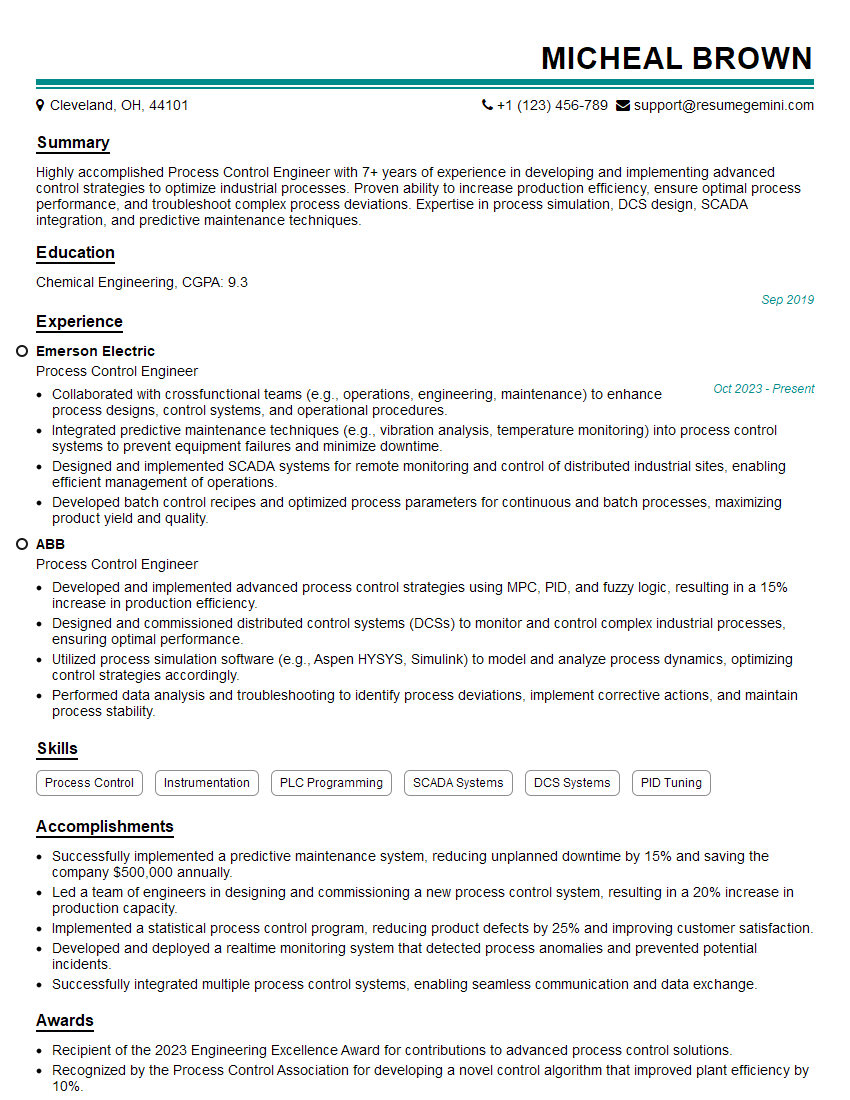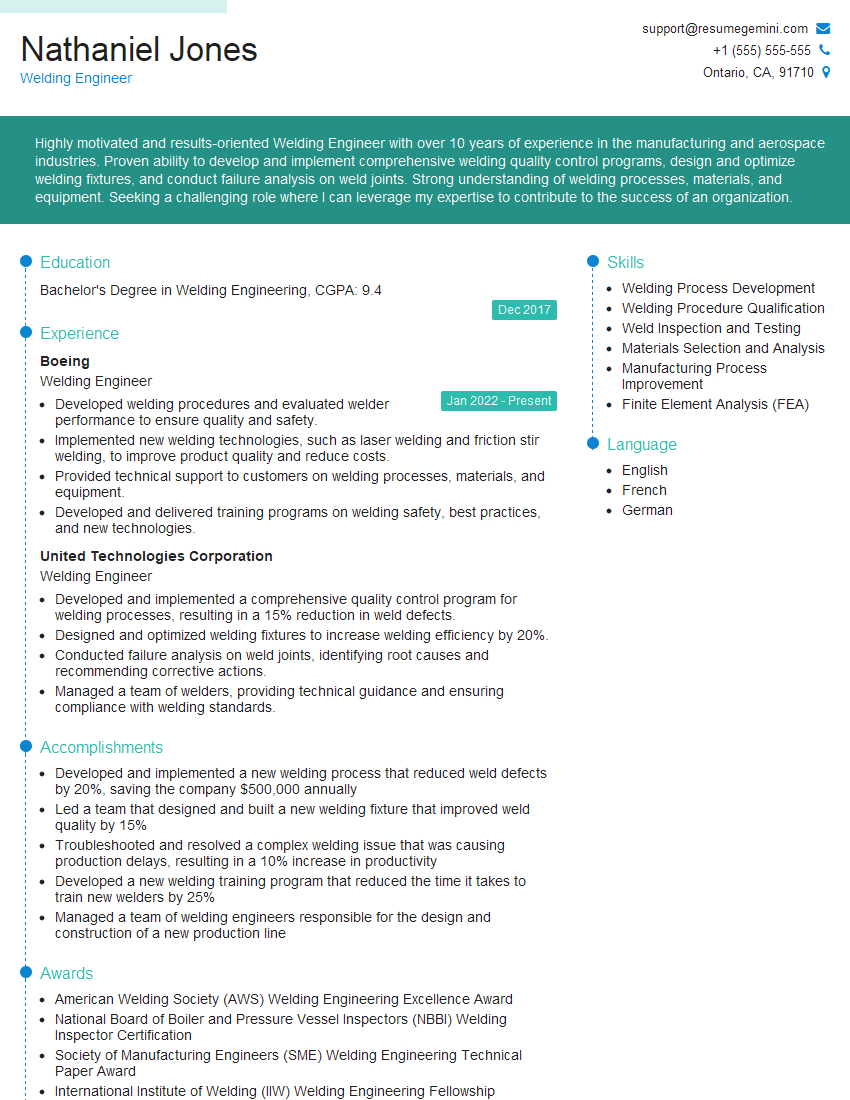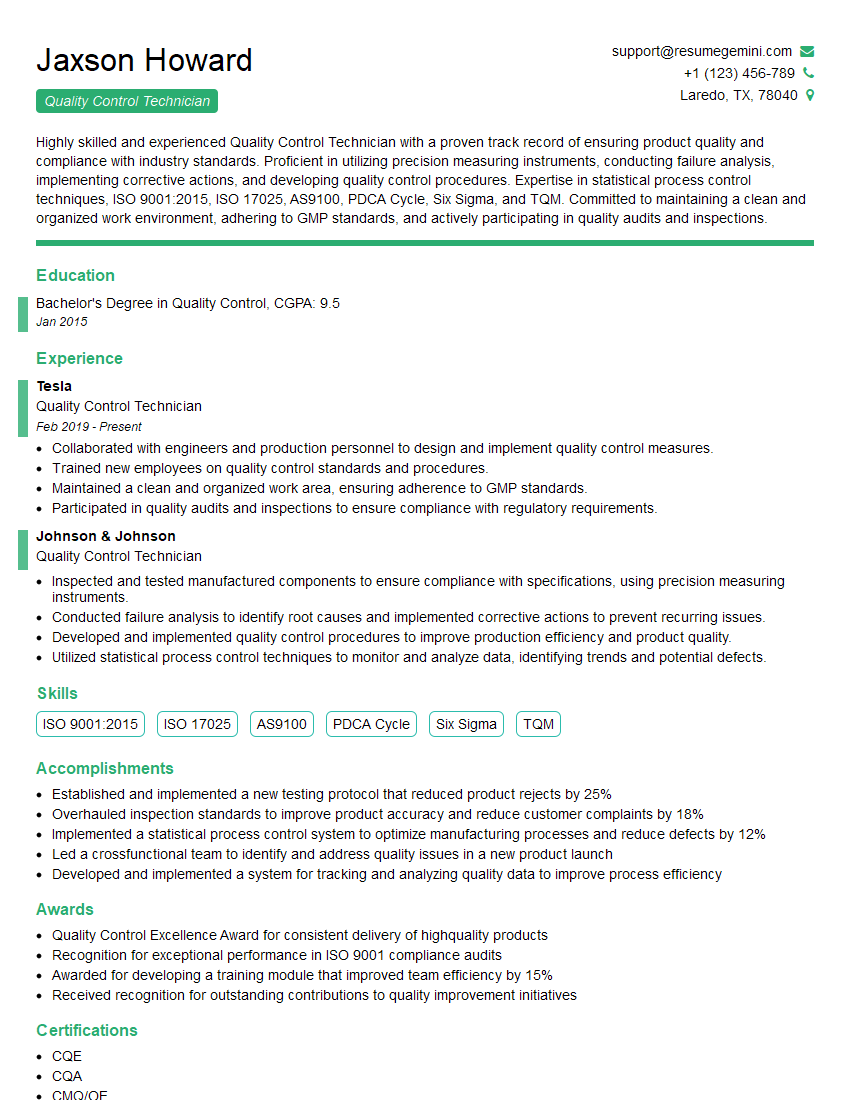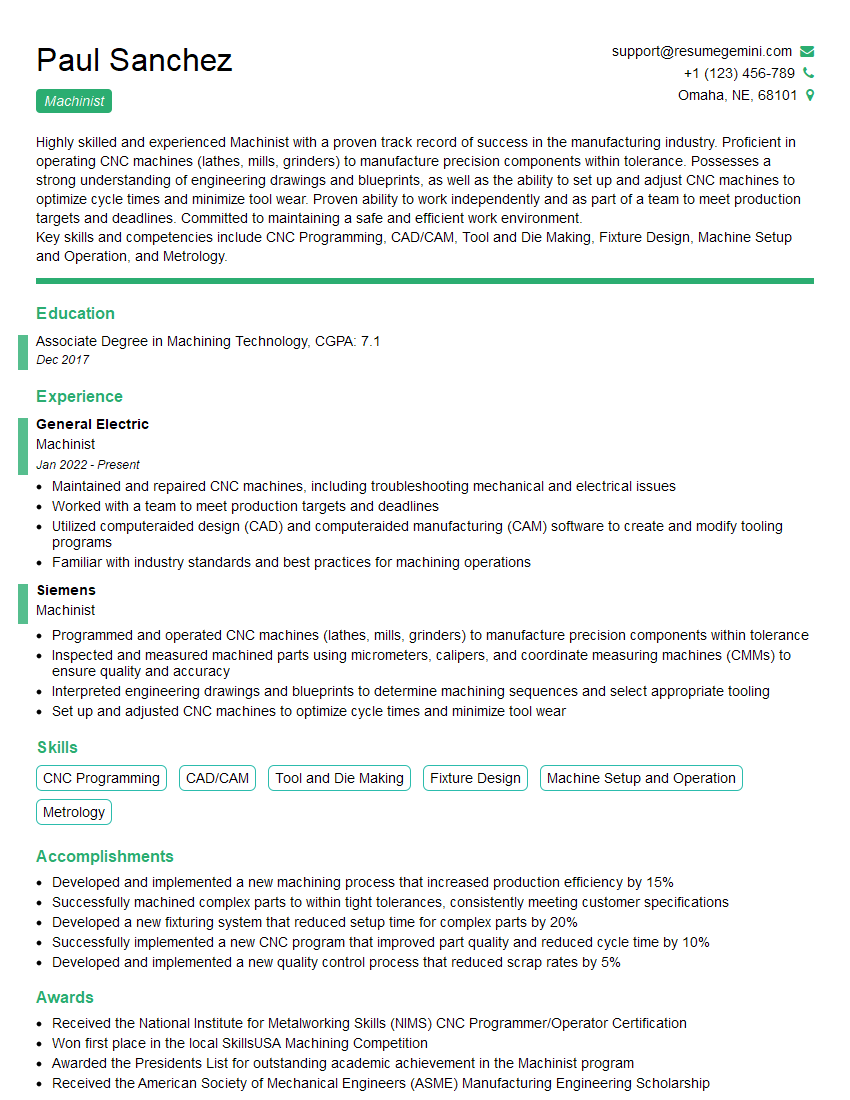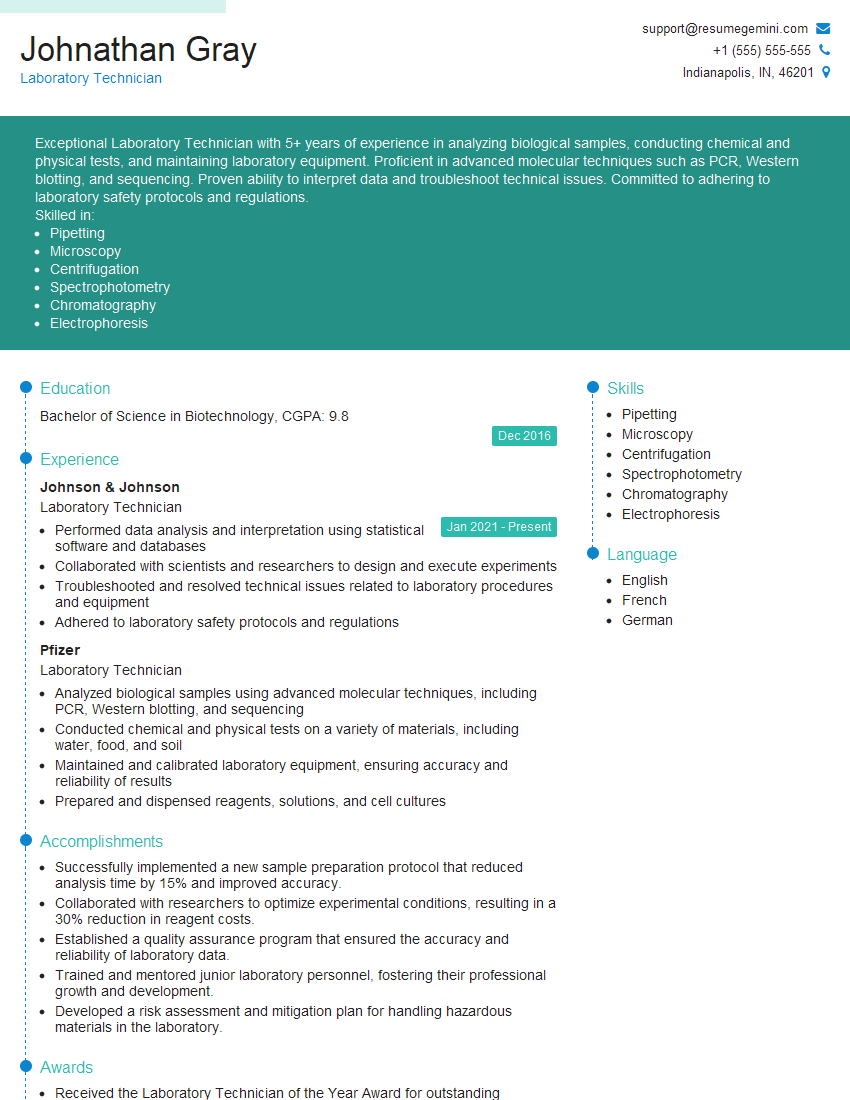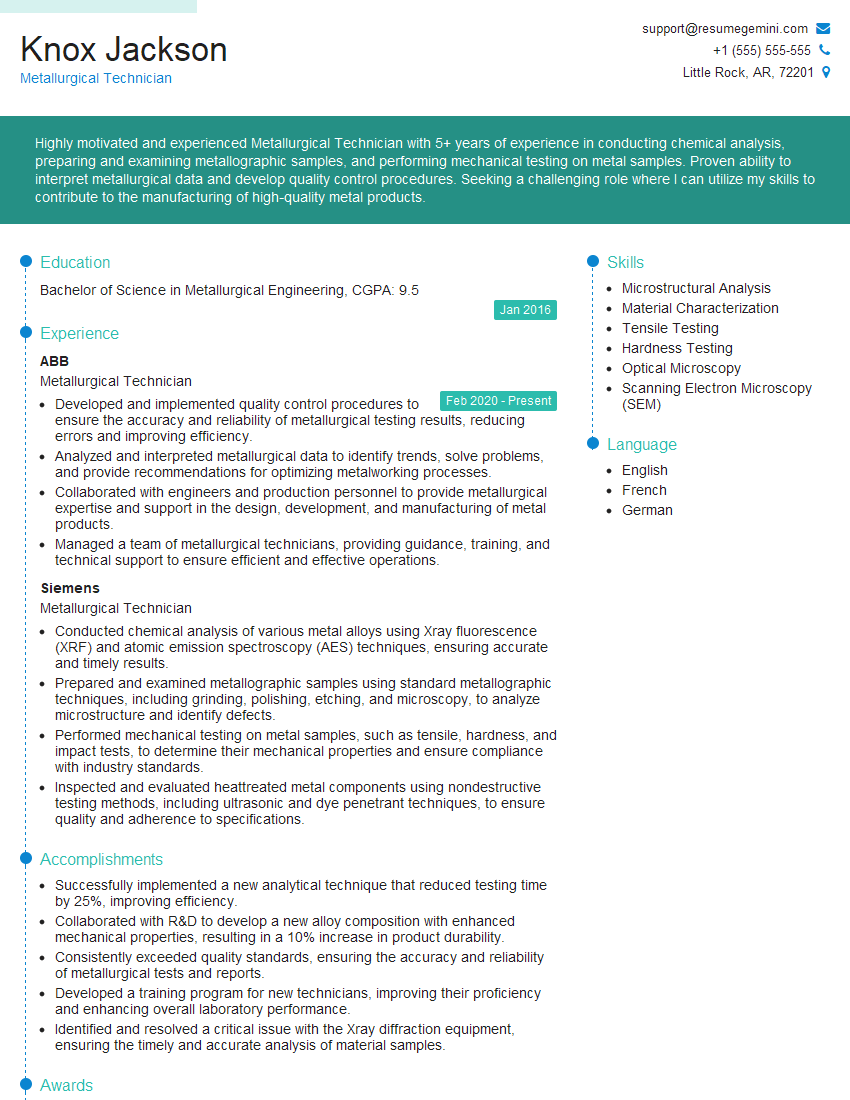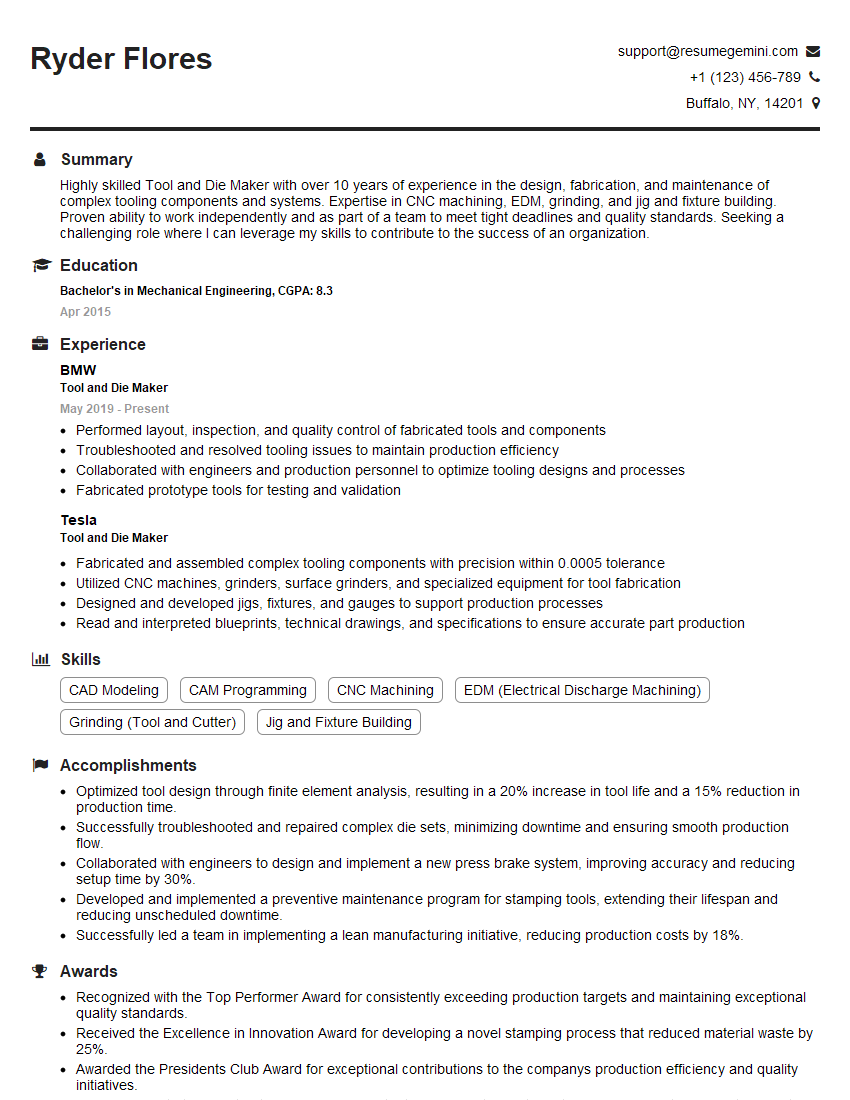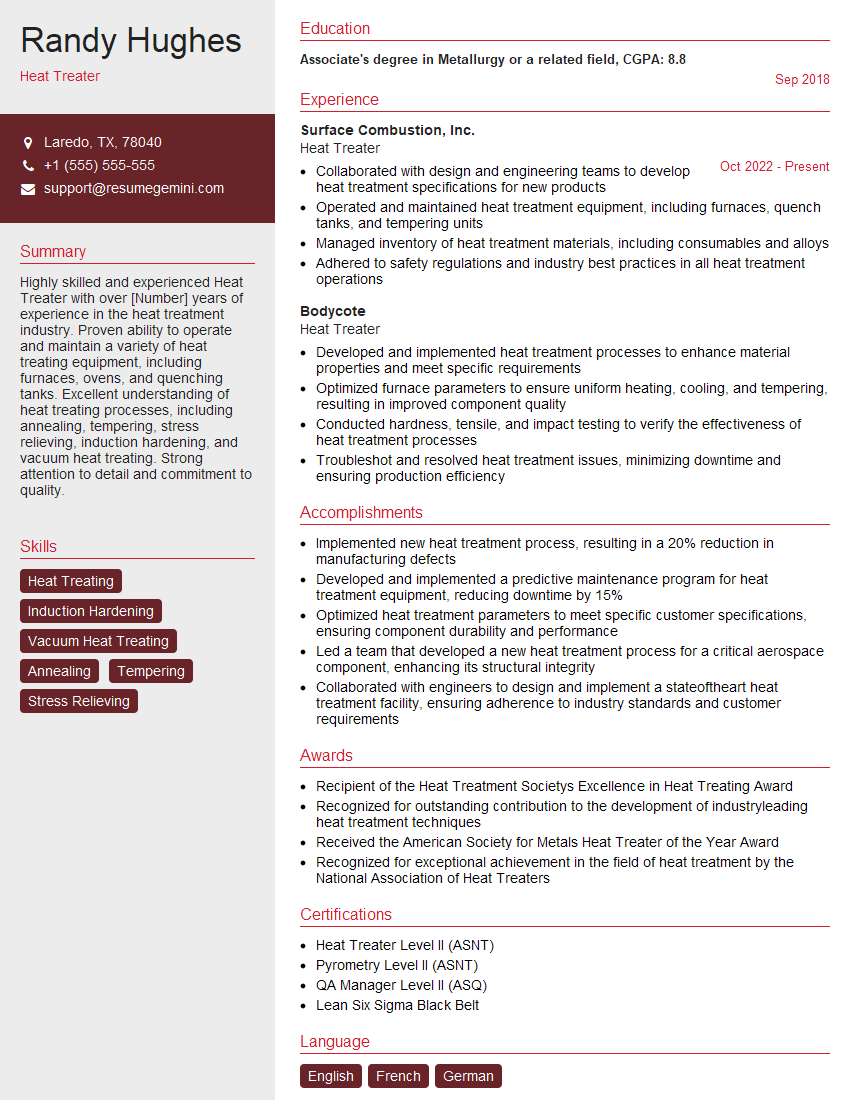Interviews are more than just a Q&A session—they’re a chance to prove your worth. This blog dives into essential Temper Hardening interview questions and expert tips to help you align your answers with what hiring managers are looking for. Start preparing to shine!
Questions Asked in Temper Hardening Interview
Q 1. Explain the principles of temper hardening.
Temper hardening, also known as tempering, is a heat treatment process used to increase the toughness and ductility of hardened steel while slightly reducing its hardness. It follows a prior hardening process, typically martensitic hardening, which leaves the steel extremely hard but brittle. The principle behind tempering lies in the controlled reheating of the hardened steel to a specific temperature below the critical transformation temperature (A1). This reheating allows for the partial reversion of the hard, brittle martensite to a more ductile microstructure, improving its impact resistance and reducing internal stresses. Think of it like carefully softening a piece of glass – you reduce the brittleness without completely losing the strength.
Q 2. Describe the stages of temper hardening.
Temper hardening isn’t a sharply defined, multi-stage process like some other heat treatments. It’s more accurately described as a single step with variations in time and temperature. The process typically involves:
- Heating: The hardened steel component is uniformly heated to the desired tempering temperature. This is usually done in a controlled atmosphere furnace to prevent oxidation or decarburization.
- Soaking: The component is held at the tempering temperature for a specified time to allow for the complete transformation of the martensite. This soak time is crucial to achieving the desired properties and is dependent on the size and geometry of the part.
- Cooling: Finally, the component is cooled, usually in air, to room temperature. The cooling rate doesn’t significantly impact the final properties in most cases, unlike the rapid quench used in martensitic hardening.
Q 3. What are the critical factors influencing the temper hardening process?
Several factors critically influence the temper hardening process, including:
- Tempering Temperature: The most significant factor. Higher temperatures lead to greater softening and ductility, but also reduced hardness. The selection of this temperature is crucial and determines the final mechanical properties.
- Soaking Time: Sufficient time at the tempering temperature is essential for complete transformation. Insufficient time can lead to uneven properties within the component.
- Steel Composition: Different steel grades respond differently to tempering. Alloying elements significantly affect the tempering behavior, influencing the hardness and toughness achievable.
- Component Size and Geometry: Larger and more complex components may require longer soak times to ensure uniform heating and transformation throughout the part. This is because heat transfer can be uneven and slow in larger components.
- Atmosphere Control: Controlling the furnace atmosphere (e.g., using inert gas) is essential to prevent oxidation or decarburization, which can affect the surface properties and overall component integrity.
Q 4. How does tempering affect the microstructure of steel?
Tempering significantly alters the steel’s microstructure. Before tempering, the steel consists primarily of martensite, a very hard but brittle tetragonal structure. During tempering, the martensite begins to decompose. At lower tempering temperatures, the decomposition forms ε-carbide and some retained austenite. As the temperature increases, cementite (Fe3C) precipitates and the microstructure transforms into a mixture of tempered martensite (which is still primarily ferrite but now finer), carbides, and retained austenite. This leads to a reduction in internal stresses and an increase in toughness and ductility. The microstructure’s evolution during tempering is complex and is influenced by several factors mentioned earlier.
Q 5. Explain the difference between martensite and tempered martensite.
Martensite and tempered martensite are distinct microstructures with significantly different properties. Martensite is a hard, brittle, metastable phase formed by the rapid quenching of austenite. It has a body-centered tetragonal crystal structure with carbon atoms trapped within the iron lattice. This high carbon concentration in the iron lattice makes it exceptionally hard but also very brittle, susceptible to cracking under impact loads. Tempered martensite, on the other hand, is a product of heating martensite to a specific temperature, causing the carbon atoms to segregate out of the iron lattice and form carbide precipitates. This process reduces the internal stresses present in martensite and results in a more ductile and tougher microstructure. The final structure remains largely ferritic but the presence of finely dispersed carbides makes it stronger than a solely ferritic structure. Think of it as the difference between a very hard but easily shattered piece of glass and a more flexible but still strong piece of tempered glass.
Q 6. How do you determine the optimal tempering temperature?
Determining the optimal tempering temperature depends on the desired mechanical properties and the steel’s composition. It’s usually determined through experimentation, often aided by metallurgical testing and knowledge of the steel grade’s tempering curves. These curves show the relationship between tempering temperature and the resulting hardness, tensile strength, and yield strength. Alternatively, one could use a combination of the following:
- Hardness Testing: Monitoring hardness changes during tempering provides a direct measure of the softening process.
- Tensile Testing: This reveals changes in strength and ductility.
- Impact Testing: Measures toughness and assesses the resistance to fracture under impact loading.
- Microstructural Analysis: Using techniques like optical or electron microscopy to directly observe the microstructural changes.
Many times, empirical data for a similar steel grade can be used as a starting point, but adjustments might be necessary based on specific requirements.
Q 7. What are the common tempering methods?
Common tempering methods include:
- Furnace Tempering: The most common method, involving controlled heating in a furnace, offering excellent uniformity. This is ideal for large or complex parts.
- Salt Bath Tempering: Uses molten salt baths for rapid and uniform heating. This is efficient for smaller parts and offers excellent temperature control.
- Induction Tempering: Utilizes electromagnetic induction to heat the component, offering precise control and speed, especially suitable for selective heating of certain areas.
The choice of method depends on factors like part size, geometry, production volume, and required temperature uniformity. For instance, a very large part would benefit more from furnace tempering, ensuring uniform heating throughout its volume. In contrast, salt bath tempering is more suitable for mass-production of smaller components needing fast and uniform heat treatment.
Q 8. What are the effects of over-tempering?
Over-tempering occurs when a steel component is subjected to a tempering temperature that’s too high or for too long a duration. The primary effect is a significant reduction in hardness and strength. Think of it like overcooking a steak – you lose the desired texture and tenderness. In over-tempered steel, the martensite, the hard phase formed during quenching, transforms further into softer phases, primarily ferrite and cementite. This results in a loss of the desirable properties that the heat treatment aimed to achieve. For example, a tool designed for cutting might become too soft to maintain a sharp edge, or a spring might lose its elasticity. The precise effect depends on the steel grade, initial hardness, and the tempering parameters.
Example: A high-speed steel cutting tool meant to have a Rockwell C hardness of 62-65 might drop to 55-60 after over-tempering, significantly impacting its cutting performance.
Q 9. What are the effects of under-tempering?
Under-tempering, conversely, happens when the tempering process is insufficient, either too low temperature or insufficient time. This leaves residual internal stresses within the steel, making it brittle and prone to cracking or fracturing under stress. It’s akin to trying to build a house without properly drying the wood – it might look sturdy initially but will quickly weaken and potentially collapse. The material retains much of its initial hardness but lacks toughness and ductility. This can lead to premature failure in applications where impact resistance or flexibility is crucial.
Example: A spring that’s under-tempered might fracture easily under load due to its high brittleness despite its hardness.
Q 10. How do you control the tempering process to achieve specific mechanical properties?
Controlling the tempering process for specific mechanical properties requires careful management of both temperature and time. The desired hardness and toughness dictate the tempering parameters. Precise temperature control is achieved using furnaces with accurate temperature monitoring and regulation. Time control involves carefully calculating the soaking time at the chosen temperature. Often, a trial-and-error approach or prior experience with similar materials might be used, but also more sophisticated methods like using TTT diagrams are applied. Different steels react differently to tempering, so prior testing of the specific steel grade is essential.
Step-by-step approach:
- Determine the desired mechanical properties: Specify the required hardness, tensile strength, yield strength, and ductility.
- Select the appropriate steel grade: Choose a steel grade suitable for the application and desired properties.
- Consult a TTT diagram (Isothermal Transformation Diagram): These diagrams guide the selection of tempering temperature and time to achieve the target microstructure.
- Heat the steel to the tempering temperature: Use a furnace with precise temperature control.
- Maintain the temperature for the specified time: Ensure uniform heating throughout the component.
- Cool the steel slowly: Usually, cooling in air is sufficient.
- Verify the mechanical properties: Use hardness testing and tensile testing to confirm the achieved properties.
Q 11. Describe the relationship between tempering temperature and hardness.
The relationship between tempering temperature and hardness is inversely proportional. As the tempering temperature increases, the hardness of the steel decreases. This is because higher temperatures allow for more extensive relaxation of internal stresses and the transformation of martensite into softer phases. Think of it as heat ‘softening’ the steel. This relationship isn’t perfectly linear; the rate of hardness reduction changes as the temperature rises and is significantly dependent on the alloying elements in the steel. A lower tempering temperature retains more hardness but might result in higher brittleness; a higher temperature produces a tougher but softer material.
Example: Tempering a high-carbon steel at 200°C might yield a much higher hardness than tempering the same steel at 500°C.
Q 12. How do you measure the hardness of tempered steel?
Hardness of tempered steel is commonly measured using hardness testing methods, primarily Rockwell and Brinell hardness tests. The Rockwell test uses an indenter to measure the depth of penetration under a specific load, while the Brinell test measures the diameter of the indentation created by a hardened steel ball. The appropriate scale (e.g., Rockwell C scale for hardened steel) is selected based on the expected hardness range. The choice between Rockwell and Brinell depends on the size and shape of the component and the desired accuracy.
Example: Rockwell C hardness testing is frequently used for hardened and tempered tool steels, while Brinell hardness might be more suitable for larger components.
Q 13. Explain the use of TTT diagrams in temper hardening.
Isothermal Transformation (TTT) diagrams, also known as time-temperature-transformation diagrams, are crucial for understanding and controlling the tempering process. These diagrams graphically illustrate the transformation kinetics of austenite (a high-temperature phase of steel) to other phases, such as martensite, bainite, and pearlite, under different cooling conditions. By carefully studying the TTT diagram for a specific steel grade, one can determine the appropriate tempering temperature and time to achieve the desired microstructure and, consequently, the desired mechanical properties. The ‘nose’ of the curve in a TTT diagram often indicates the transformation time to obtain the lowest hardness. Tempering essentially involves heating the quenched steel (usually martensite) into the region beyond the nose, promoting the formation of more stable phases and reducing hardness, adjusting the properties accordingly.
Example: A TTT diagram allows a metallurgist to predict the time needed at a specific tempering temperature to reach a certain level of hardness or to reduce the internal stresses and increase the toughness.
Q 14. What are the common types of steel suitable for temper hardening?
Many types of steel are suitable for temper hardening, primarily those that can be effectively hardened by heat treatment (quenching and tempering). The most common types include:
- High-carbon steels: These steels contain a high percentage of carbon (typically above 0.6%), resulting in high hardness when quenched and tempered. They are commonly used in tools, springs, and other applications requiring high strength and wear resistance.
- Alloy steels: These steels contain alloying elements like chromium, molybdenum, nickel, and vanadium, which enhance hardenability and toughness. Examples include high-speed steels, used in cutting tools, and various tool and die steels.
- Tool steels: A broad category of steels designed for specific tooling applications. They possess superior hardness, wear resistance, and toughness after appropriate heat treatments.
The specific steel grade selected depends on the application’s requirements. The choice is governed by considerations of hardness, toughness, wear resistance, and cost.
Q 15. How does alloying affect the temper hardening process?
Alloying elements significantly influence temper hardening by altering the steel’s microstructure and thus its response to heat treatment. Think of it like adding spices to a recipe – each element contributes unique properties. For example, chromium (Cr), molybdenum (Mo), and vanadium (V) enhance hardenability, allowing for deeper hardening during quenching. This means a larger volume of the steel will transform to martensite, resulting in a stronger and tougher final product. Conversely, elements like nickel (Ni) and manganese (Mn) can reduce the tendency for brittleness during tempering, improving the steel’s toughness. The precise effect depends on the specific alloying elements, their concentrations, and the chosen tempering temperature. For instance, a high-speed steel tool, rich in tungsten (W) and molybdenum (Mo), will respond very differently to tempering than a low-alloy structural steel.
Let’s illustrate this: A simple carbon steel might require a lower tempering temperature to achieve a specific hardness compared to a more complex alloy steel with multiple alloying additions. The added elements can slow down the tempering process, allowing for finer control over the final properties.
Career Expert Tips:
- Ace those interviews! Prepare effectively by reviewing the Top 50 Most Common Interview Questions on ResumeGemini.
- Navigate your job search with confidence! Explore a wide range of Career Tips on ResumeGemini. Learn about common challenges and recommendations to overcome them.
- Craft the perfect resume! Master the Art of Resume Writing with ResumeGemini’s guide. Showcase your unique qualifications and achievements effectively.
- Don’t miss out on holiday savings! Build your dream resume with ResumeGemini’s ATS optimized templates.
Q 16. Explain the concept of temper embrittlement.
Temper embrittlement is a phenomenon where the toughness of a steel is reduced after tempering, particularly at lower tempering temperatures (typically below 500°C or 932°F). Imagine a tempered sword suddenly becoming brittle – that’s essentially temper embrittlement. It’s caused by the segregation of embrittling elements, such as phosphorus (P) and antimony (Sb), to the grain boundaries of the steel. These elements impede the movement of dislocations (crystal imperfections that contribute to plasticity), making the steel more susceptible to cracking under stress. The severity of embrittlement depends on factors such as the steel’s composition, the tempering temperature, and the time spent at that temperature.
For example, a high-strength steel component that’s used in an aircraft might experience reduced fracture toughness if it undergoes improper tempering. The consequences of this can be catastrophic.
Q 17. How can you prevent temper embrittlement?
Preventing temper embrittlement involves a multi-pronged approach focusing on material selection, processing, and heat treatment.
- Material Selection: Using steels with low levels of embrittling elements (P and Sb) is the most effective prevention method. Steel manufacturers specify the maximum allowable content of these elements to meet certain toughness requirements.
- Controlled Tempering: Tempering at higher temperatures (above 500°C) significantly reduces the risk of embrittlement, though this may compromise the desired hardness. A rapid cool-down after tempering prevents further embrittlement.
- Post-Tempering Heat Treatment: Specific post-tempering heat treatments, such as stress relieving, can alleviate the internal stresses contributing to embrittlement.
- Modifying the steel’s microstructure: Adding elements such as Nb or V can modify the grain boundary structure and reduce segregation of embrittling elements.
These strategies should be carefully considered and tailored to the specific application. Improperly tempered materials can lead to unexpected failures, so the chosen approach should be fully validated.
Q 18. Describe the various types of tempering furnaces.
Various types of furnaces are used for tempering, each with its own advantages and disadvantages depending on the specific requirements.
- Batch Furnaces: These are commonly used for smaller production runs, offering good control over temperature uniformity but with longer cycle times. Think of them as ovens for steel, holding a batch of parts at the required tempering temperature.
- Continuous Furnaces: Ideal for high-volume production, these furnaces continuously move the parts through different temperature zones, offering high throughput and improved efficiency. Imagine a conveyor belt slowly transporting the parts through a heating and cooling process.
- Salt Baths: This method provides rapid heating and excellent temperature uniformity, but requires careful handling due to the molten salt’s high temperature and corrosive nature. The parts are immersed in a salt bath maintained at the tempering temperature.
- Electric Furnaces: These offer precise temperature control and cleaner heating compared to gas furnaces, but can be more expensive to operate. These use electricity as the primary heat source.
The choice of furnace depends on factors such as production volume, desired temperature accuracy, and budget.
Q 19. What are the safety precautions necessary during temper hardening?
Safety is paramount during temper hardening. High temperatures and potential for burns are major concerns. Here are key precautions:
- Personal Protective Equipment (PPE): Always wear heat-resistant gloves, safety glasses, and long sleeves to protect against burns and flying debris.
- Proper Handling of Hot Parts: Use appropriate tongs, gloves, and other tools to handle hot parts and avoid direct contact.
- Ventilation: Ensure adequate ventilation to remove any harmful fumes or gases generated during the heating process.
- Fire Safety: Have fire extinguishers readily available and follow fire safety procedures. Many tempering processes occur at temperatures well above the ignition point of many materials.
- Temperature Monitoring and Control: Use accurate temperature sensors and controllers to maintain the desired tempering temperature and prevent overheating or underheating.
- Emergency Procedures: Establish clear emergency procedures for handling accidents or equipment malfunctions.
Adherence to these safety procedures helps minimize the risk of injury and ensures efficient and safe operations.
Q 20. What are the common defects observed in tempered steel?
Several defects can arise during temper hardening, negatively impacting the final product’s properties and serviceability.
- Overtempering: This occurs when the steel is tempered at too high a temperature for too long, leading to a significant reduction in hardness and strength. The microstructure becomes too soft.
- Undertempering: This results from insufficient tempering time or temperature, leaving residual internal stresses and brittleness. The part may be too hard and brittle.
- Scale Formation: Oxidation at high temperatures can create a layer of scale on the surface of the steel, impacting its appearance and potentially reducing dimensional accuracy. This can be avoided through controlled atmosphere tempering or surface coatings.
- Decarburization: Carbon loss from the surface layer due to exposure to oxidizing atmospheres at high temperatures. This leads to decreased surface hardness and wear resistance.
- Distortion: Uneven heating or cooling can cause distortion and warping of the part, requiring corrective machining or finishing.
Careful control of the tempering process parameters is essential to minimize these defects.
Q 21. How do you troubleshoot issues in the temper hardening process?
Troubleshooting temper hardening issues requires a systematic approach. Here’s a step-by-step strategy:
- Identify the Defect: Carefully examine the tempered parts to identify the type and extent of the defect (e.g., excessive hardness, brittleness, distortion, scale formation).
- Analyze Process Parameters: Review the tempering parameters, including temperature, time, and atmosphere, comparing them to established specifications.
- Check Material Properties: Verify the chemical composition and microstructure of the steel to rule out any material-related issues.
- Inspect Equipment: Inspect the furnace and other equipment for any malfunctions or inconsistencies in temperature control and atmosphere.
- Adjust Parameters: Based on the analysis, adjust the tempering parameters (temperature, time, atmosphere) accordingly. This may involve iterative adjustments until the desired properties are achieved.
- Repeat and Verify: After making adjustments, repeat the tempering process and verify the results through mechanical testing and microstructural analysis to confirm the improvement.
- Implement Preventative Measures: Based on the root cause analysis, implement preventative measures to avoid similar issues in the future.
A thorough understanding of the tempering process and its variables is crucial for effective troubleshooting. Often, detailed record-keeping and quality control procedures are crucial for identifying trends and preventing recurring problems.
Q 22. Describe your experience with different tempering atmospheres.
Tempering atmospheres play a crucial role in controlling the final properties of the hardened steel. Different atmospheres offer varying degrees of protection against oxidation and decarburization, ensuring consistent and predictable results. My experience encompasses a wide range of atmospheres, including:
- Protective Atmospheres: These, such as endothermic or exothermic gas mixtures, prevent oxidation and decarburization by maintaining a reducing environment within the furnace. I’ve extensively used these for critical components requiring a high degree of surface quality.
- Neutral Atmospheres: Argon or nitrogen are examples. These minimize interactions between the steel and the atmosphere, preventing both oxidation and decarburization. I often select neutral atmospheres when precision is paramount and surface finish is critical.
- Oxidizing Atmospheres: While less common for tempering, controlled oxidizing atmospheres can be used in specific cases to create a very thin oxide layer on the surface, beneficial in certain applications. My experience includes using controlled oxidizing atmospheres to achieve specific surface finishes for decorative purposes.
The choice of atmosphere depends heavily on the type of steel, the desired final properties, and the cost considerations. For example, a high-value component might warrant the expense of a protective atmosphere, while a less critical part may be tempered in a simpler, less expensive neutral atmosphere.
Q 23. How do you verify the effectiveness of the temper hardening process?
Verifying the effectiveness of temper hardening is crucial for ensuring the final product meets specifications. We employ a multi-pronged approach:
- Hardness Testing: Rockwell, Brinell, or Vickers hardness tests are performed to measure the final hardness. This is the most common and critical verification method. The hardness value should fall within the specified range dictated by the material and application requirements. For example, a spring might require a specific hardness range to ensure proper elasticity and strength.
- Microstructural Analysis: Metallographic examination reveals the microstructure of the tempered steel, allowing us to assess the effectiveness of the tempering process in achieving the desired microstructure. This helps identify any anomalies like incomplete tempering or uneven hardness.
- Dimensional Measurement: Dimensional changes occur during the heat treatment process. Accurate dimensional checks ensure the part is within tolerances. In some critical applications, even minor dimensional changes can be unacceptable.
- Mechanical Testing: Tensile, impact, or fatigue tests may be performed on representative samples, depending on the application’s requirements. These tests evaluate the final mechanical properties of the tempered steel, ensuring it meets the necessary strength, toughness, and durability criteria.
Combining these methods provides a holistic verification of the tempering process’s effectiveness.
Q 24. Explain the role of quality control in temper hardening.
Quality control is paramount in temper hardening, ensuring consistent and reliable results. It involves a systematic approach across all stages:
- Input Material Control: Verification of the incoming steel’s chemical composition and initial hardness is critical. Inconsistencies in the input material can lead to variations in the final product.
- Process Parameter Control: Precise control over temperature, time, and atmosphere is essential. Deviation from the specified parameters can significantly affect the final hardness and microstructure. We use sophisticated control systems and regular calibration to maintain precise control.
- In-Process Monitoring: Regular monitoring of the furnace atmosphere and temperature during the tempering process is crucial to detect and correct any deviations promptly. Real-time data logging aids in process optimization and problem-solving.
- Output Quality Verification: Hardness testing, microstructural analysis, and dimensional checks are performed on the finished parts to ensure they meet the required specifications. Statistical process control (SPC) charts help monitor the process capability and identify any potential issues.
- Documentation and traceability: Maintaining detailed records of all process parameters, test results, and corrective actions is essential for ensuring traceability and accountability.
A robust quality control system prevents costly errors and ensures the production of high-quality tempered parts.
Q 25. How do you interpret and utilize hardness test results?
Hardness test results are interpreted in the context of the material specifications and the desired properties. The actual hardness value is compared against the specified range. For example, a Rockwell C hardness of 50-55 might be specified for a particular application.
Deviations from the specified range are carefully analyzed. A hardness value below the lower limit suggests insufficient tempering, while a value above the upper limit indicates over-tempering. We investigate the root cause of any deviation, examining process parameters and input materials to determine the source of error and implement corrective measures. For instance, consistently low hardness readings might indicate a furnace temperature calibration issue, prompting recalibration and adjustments.
The interpretation of hardness results isn’t isolated. We always correlate it with other quality control data, including microstructural analysis and dimensional measurements, to provide a complete picture of the temper hardening process’s effectiveness.
Q 26. Describe your experience with statistical process control (SPC) in heat treatment.
Statistical Process Control (SPC) is integral to maintaining the consistency and predictability of heat treatment processes. We utilize control charts, such as X-bar and R charts, to monitor key process parameters, including temperature, time, and hardness. These charts visually display the process’s variability over time, allowing us to identify trends and potential problems before they lead to significant deviations from specifications.
For example, an upward trend in the average hardness value on our control charts might signal a slow drift in the furnace temperature, prompting an investigation and recalibration. Similarly, an increase in the range of hardness values indicates increased variability and might point towards inconsistencies in the input material or process parameters.
SPC provides the data-driven insights necessary for proactive process adjustments, ultimately enhancing the quality and consistency of tempered parts. Regular analysis of SPC charts informs process optimization and contributes to continuous improvement initiatives.
Q 27. How do you select appropriate equipment for a temper hardening process?
Equipment selection for temper hardening is guided by several factors, including:
- Production Volume: High-volume production often necessitates continuous furnaces or large-batch furnaces with automated loading and unloading systems, while smaller-scale operations may suffice with smaller, batch-type furnaces.
- Temperature Range and Control: The furnace must precisely control the temperature within the required range, with high accuracy and uniformity. Advanced control systems with PID controllers are often employed.
- Atmosphere Control: The choice of furnace type depends heavily on the desired atmosphere control. Some furnaces are designed for specific atmospheres, such as endothermic or exothermic gas mixtures, while others can handle more general neutral or oxidizing atmospheres.
- Material Handling: The handling system must be appropriate for the type and size of parts being treated, accommodating safe and efficient loading and unloading.
- Safety Features: Safety is a paramount concern. The chosen equipment should incorporate appropriate safety features like emergency shut-off mechanisms and appropriate ventilation systems.
A thorough cost-benefit analysis is conducted before selecting equipment, considering initial investment costs, operating expenses, and long-term maintenance requirements. For instance, the higher initial cost of a more automated system might be justified by its improved efficiency and reduced labor costs in high-volume production.
Q 28. What are the environmental considerations in temper hardening?
Environmental considerations in temper hardening are increasingly important due to environmental regulations and sustainability goals. Key concerns include:
- Emission Control: Furnaces often release combustion byproducts, depending on the atmosphere used. Effective emission control systems, such as scrubbers or catalytic converters, are essential to minimize environmental impact and comply with regulations. This is particularly critical when using gas-fired furnaces.
- Energy Efficiency: Choosing energy-efficient furnaces and optimizing the tempering process to minimize energy consumption are crucial for reducing carbon footprint and operational costs. This may involve implementing measures like improved insulation and optimized heating schedules.
- Waste Management: Proper disposal of any waste materials generated during the process, such as spent atmosphere gases or used quenching fluids, is important to comply with environmental regulations and promote responsible waste management practices.
- Water Usage: Some quenching methods utilize water. Implementing water-saving strategies is crucial, especially in regions with water scarcity issues.
Addressing these environmental concerns is crucial for both regulatory compliance and the adoption of sustainable manufacturing practices within the heat treatment industry.
Key Topics to Learn for Temper Hardening Interview
- Iron-Carbon Diagram & Phase Transformations: Understand the critical role of the iron-carbon diagram in predicting the microstructure and properties achievable through tempering. Be prepared to discuss the different phases (austenite, martensite, pearlite, bainite) and their transformations during the tempering process.
- Mechanisms of Tempering: Explain the process of tempering, focusing on the changes in microstructure and mechanical properties (hardness, strength, toughness) that occur as a result of carbide precipitation and dislocation rearrangement.
- Influence of Alloying Elements: Discuss how alloying elements modify the tempering response. Understand the effect of elements such as chromium, molybdenum, nickel, and tungsten on the tempering temperature, hardness retention, and overall mechanical properties.
- Practical Applications of Temper Hardening: Provide examples of how temper hardening is used to achieve desired properties in various applications, such as tools, springs, and structural components. Be prepared to discuss specific case studies or examples from your experience.
- Controlling Tempering Parameters: Explain the importance of controlling tempering parameters such as time and temperature, and how these parameters influence the final microstructure and properties. Understand the challenges and potential pitfalls of incorrect tempering practices.
- Residual Stress and Distortion: Discuss the potential for residual stresses and distortion to develop during tempering and describe methods for minimizing these effects.
- Testing and Characterization Techniques: Be familiar with various testing methods used to characterize the properties of tempered steel, such as hardness testing (Rockwell, Brinell), tensile testing, and microstructure analysis (optical microscopy, SEM).
- Troubleshooting Tempering Issues: Demonstrate your ability to identify and solve common problems encountered during tempering, such as insufficient hardening, excessive softening, or distortion.
Next Steps
Mastering temper hardening principles is crucial for career advancement in materials science and engineering. A strong understanding of this process demonstrates a valuable skill set highly sought after by employers. To maximize your job prospects, create a compelling, ATS-friendly resume that highlights your expertise. ResumeGemini is a trusted resource that can help you build a professional and effective resume tailored to the specific requirements of your target roles. Examples of resumes tailored to Temper Hardening are available to further assist you in showcasing your skills and experience.
Explore more articles
Users Rating of Our Blogs
Share Your Experience
We value your feedback! Please rate our content and share your thoughts (optional).
What Readers Say About Our Blog
good








